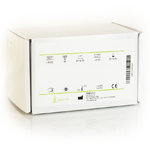| Method & Line | Sample & Target | Product | Package Info | Product | Package Info |
|---|---|---|---|---|---|
| MicroELISA | Plasma,Serum | EIAgen Total T3 Kit | Tests per Package: 96 | ||
| EIAgen | EIAgen Total T3 Kit is a direct solid phase enzyme immunoassay for the quantitative measurement of total 3,5,3’-triiodothyronine (T3) in human serum or plasma. | Code: LI4019B | Package: 1 Microplate |

For Quantity Orders: Request a Quote
Please pay attention to the revision of the document that must be the same as the revision reported in the box label.
In case of discrepancy please contact our Customer Care e-mail: info@adaltis.net.
* Other document related to the product available at Documentation Centre and it is accessible for Adaltis distributors/partners after registration only.
EIAgen Total T3 Kit is a direct solid phase enzyme immunoassay for the quantitative measurement of total 3,5,3’-triiodothyronine (T3) in human serum or plasma.
Thyroxine (T4) and 3,5,3’-triiodothyronine (T3) are the two principal thyroid hormones. In contrast to T4, which is exclusively a product of the thyroid gland, T3 is mainly produced in the peripheral tissues by 5’-monodeiodination of circulating T4. In normal adults about 80% of T3 is produced by peripheral conversion and about 20% is secreted directly by the thyroid. A small amount of T4 is 5-monodeiodinated to form 3,3’,5’-triiodothyronine (reverse T3); this is probably biologically inactive. The proportion of T4 converted to reverse T3 may be increased under certain circumstances, such as severe illness or medication with Amodiarone or radiographic contrast agents. This reduces the production and hence the circulating level of T3. Considerable evidence exists to show that T3 is the more active thyroid hormone and some authors have suggested that T4 has no intrinsic activity. Both T3 and T4 circulate in association with serum proteins, the most important of which is thyroxine binding globulin (TBG). This has a higher affinity for T4 than for T3. Approximately 80% of circulating T3 is bound to TBG. Most of the rest is bound to prealbumin and albumin; only about 0.5% of T3 is “free” in serum (i.e. not bound to serum proteins). The concentration of T3 in serum can be alterated by a change in the activity of the thyroid gland or by alteration in the peripheral metabolism of T4. The thyroid is under the control of thyroid stimulating hormone (TSH) which in turn is regulated by hypothalamic thyrotrophin-releasing hormone (TRH). T3 exerts a negative feedback control on the release of TSH which is principally at the level of the pituitary. A slight elevation in T3 levels above normal will block TSH release in normal subjects; this block cannot be overcome by increasing doses of TRH. Measurement of the concentration of T3 in serum is most useful in the diagosis of hyperthyroidism. In the majority of patients with this condition, circulating total T4 and T3 are both elevated. In some cases, however, the hyperthyroidism results solely from an increased production of T3, a condition referred to as “T3 thyrotoxicosis”. Elevated T3 levels with normal T4 may also be found in euthyroid partients with autonomous thyroid function (ophtalmic Graves’ disease, autonomous nodules). It may be seen also as a compensatory phenomenon in patients with subclinical hypothyroidism and elevated TSH secretion. In severe hypothyroidism, total T3 levels are usually low, but in moderate hypothyroidism they may be normal. In severe non-thyroidal illness or after surgery, T3 levels are often low, with elevated production of reverse T3. T3 levels are generally higher in the newborn and infants and may be lower in older people.
Serum T3 values also vary with TBG concentration, being lower when TBG levels are low (as in liver disease, or congenital TBG deficiency) and higher during pregnancy or estrogen therapy.
Sample of serum or plasma is pipetted into the well coated with Streptavidin. The addition of the Horseradish peroxidase-T3 conjugate (HRP-T3) and of the immunological reaction starter Anti-T3-Biotin conjugate initiates the competitive assay. During the immunological incubation, the T3 of the sample competes with the HRP-T3 conjugate for the anti-T3 binding sites of the biotinilated antibody which, in turn, is bound by the streptavidin coated wells through the biotin moiety. After washing off the non-reacted species, the amount of the immunological complex remained bound to the wells
streptavidin : Biotin-Anti-T3 : T3-HRP
is revealed by the incubation with the chromogen/substrate. The blue colour development is then stopped with sulphuric acid, turning the final solution to a yellow colour which is measured photometrically at 450 nm. The intensity of the colour is proportional to the bound HRP-T3 conjugate, and therefore inversely related to the amount of T3 in the sample.
By reference to a series of T3 calibrators, assayed in the same way, the concentration of T3 in the unknown sample is quantified.
Each kit contains sufficient reagents to perform 96 tests (code LI4019B).
Bring reagents to room temperature before use.
|
StreptavidinMicroplate Calibrators Conjugate Anti-T3-Biotin Conjugate Substrate TMB Stop Solution Wash Buffer Conc. 10x Adhesive Films |
1 6x1 mL/vials 1x8 mL/vial 1x8 mL/vial 1x16 mL/vial 1x15 mL/vial 1x50 mL/vial 2 |
|
Number of tests |
96 |
|
Code |
LI4019B |
Need assistance to make an order? Contact Sales & Orders Centre order@adaltis.net.
For Application Support application@adaltis.net